Digital Art Weeks
Committee & Contact
Partners
Overview
Symposium
Festival
Exhibition
Digital Parcours
Workshops
Participants
Disclaimer
Last update: December 01, 2008, at 10:34 PM
Wednesday July 12
Also see → Digital Parcours for the afternoon program.
PERFORMANCE WINDOW I: "ReScored Films and Malleable Scores"
Location: Cabaret Voltaire
| 20:00-21:30 | Screening: ALLES WAS WIR HABEN, Volko Kaminsky (DEU) |
| Performance: SIGNIFIKANTENSTADL, drb (Julian Rohrhuber and Renate Wieser) (DEU) | |
| Performance: VIDEO GAME AUDIO LIVE, Leonard J. Paul (CAN) | |
| 19:30-23:00 | Bar |
Thursday July 13
PERFORMANCE WINDOW II: "Wearable Audio and Video"
Location: Cabaret Voltaire
| 20:00-21:30 | Concert: The HANDYDANDY, Bernhard Bauch, Luc Gross, Nicolaj Kirisits, Gordan Savicic, Florian Waldner (AUT) |
| Performance: 13 VOLTS and A CARROT, Eva Sjuve (SWE) | |
| Performance: VIDEO PEACOCK, Benoit Maubrey (USA/F) | |
| 19:30-23:00 | Bar |
Friday July 14
PERFORMANCE WINDOW III: "Stadt, Statt, Staat oder Satt?"
Location: Cabaret Voltaire
| 20:00-21:30 | Performance: IMPROVe, Zeenath Hasan (FIN) & Richard Widerberg (FIN) |
| Performance: staTdT_kunst_ZURICH, Hannes Raffaseder & Kurt Hörbst (AUT) | |
| Performance: TUNINGS for String Instrument and Computer, David Kim-Boyle (USA) Cello: Martin Merker (DEU) | |
| Performance: GRENZE, Patrick Fontana, Emeric Aelters and Pierre-Yves Fave (FR) | |
| 19:30-23:00 | Bar |
Saturday July 15
PERFORMANCE WINDOW IV: "SENSES AND SENSORS AT WORK" and "DANCE and DANCING"
Location: Kunstraum Walcheturm
| Session I | Senses and Sensors at Work I |
| 20:00-20:30 | Dance: STRANGER, Disappearing Acts Dance Company (USA) |
| 20:30-21:00 | Performance: 4WHEEL REMIX, Julie Andreyev & Team (CAN) |
| Session II | Senses and Sensors at Work II |
| 21:15-21:45 | Performance: HUDDLE GOINGPUBLIK, Art Clay (USA/CH) & Erratum Ensemble (INT) |
| 21:45-22:30 | Performance: S.S.S. Trio, Atau Tanaka (FRA) |
| Session III | Senses and Sensors at Work III |
| 22:45-23:30 | Performance: VIRTUAL DJ, Steve Gibson (CAN) & Corebounce (Visuals, CH) |
| 23:30-00:45 | Closing Performance: JUMP'N'RUN, Steve Gibson (CAN), Leonard J. Paul (CAN), Randy Adams (CAN) & Corebounce (CH) |
Performances
|
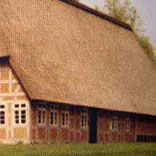 |
ALLES WAS WIR HABENVolko Kamensky (DEU) The film "Alles was wir haben" (All That We Have) focuses on a small German town, Rothenburg/Wümme. Its museum of local history is driven by the attempt to provide the area with a sense of identity by representing its history. This process of conservation takes on actual character through the endless chain of destructive arson attacks on the museum and each of its reconstructions. The somewhat ironical fact that representing history requires its very construction becomes increasingly evident in the film. Acoustically, this evidence is supported by the film sound, which can not be linked back to any form of original sound source. In contrast, all of the sounds used in the film have been generated by artificial means by using present forms of algorithmic sound synthesis. By playing with the ambiguity of origin, it blurs the distinction between diegetic and extradiegetic elements, thus avoiding the impression of 'natural', 'unconstructed' reality that is typically associated with atmospheric sound recordings, and with documentary film. http://swiki.hfbk-hamburg.de:8888/MusicTechnology/491 |
|
 |
SIGNIFIKANTENSTADLdrb: Julian Rohrhuber & Renate Wieser (DEU) Signifikantenstadl is a piece that plays with the different perceptions of film sound, technical vs. atmospheric, diegetic vs. extra-diegetic, psychological vs. material, natural vs. artificial. It combines purely synthesized sound with (visual) cinematic quotes from silent movies. The literature of writing code is combined with moments of filmic narrative, creating an ambiguity between distant and near, between extra-diegetic an diegetic sound. The piece is played with two networked laptops running SuperCollider sound synthesis language. While the DVD (edited found fottage, 20 min) is played back (DVD soundtrack is only a simulation of a film projector sound), code is executed and modified. The whole soundtrack is purely synthetic (algorithmic) without the use of any recorded sound. It is composed to relate to the film setting in such a way that it moves between athmospheric sound and film music. |
|
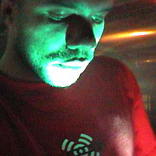 |
VIDEO GAME AUDO LIVELeonard J. Paul (CAN) As his alter-ego 'Freaky DNA', Leonard Paul is known for making electronic music which combines the dance floor with video game sounds. In a January 2005 interview, German Public Radio stated: "Doch Len Paul kommt immer wieder zurueck zu den guten alten Zeiten des Commodore 64, zumindest privat und fuer seine Musik." The show will consist of dance influenced electronic music with plenty of classic game audio references and techniques in the mix. Similar to his work on The Corporation there will be extensive use of granular synthesis and layers of processed location recordings. Visuals will be tightly tempo-sync'd via Pure Data's Graphics Extension for Multimedia (GEM) to the audio triggered by custom patches in Audio Mulch. |
|
 |
THE HANDYDANDYBauch Bernhard, Gross Luc, Kirisits Nicolaj, Savicic Gordan, Waldner Florian (AUT) The Handydandy consists of five media artists from Austria making music on their mobile telephones instead of using usual music-instruments. The mobile telephones are used only as interfaces and they are connected, via Bluetooth, to a computer network, a virtual opposite to the "human network" music-band. The entire instrument served by the musicians, is thus divided into the mobile telephones, the Bluetooth connections and the laptops acting together over WLan. Thereby different feedback systems on social and digital level, which are used for the compositions, develop. The selection of this configuration makes possible to use not only the movement in space as temporally akusmatic category but also to connect the powerful aesthetics of a Rock performance with the intellectual requirement of the electronic music. The Handydandy is at the same time a RocknRollband and a computer network - music group. The poet Charles Baudelaire wrote that an aspiring dandy must have "no profession other than elegance... no other status but that of cultivating the idea of beauty in their own persons. . . he must live and sleep before a mirror." |
|
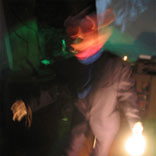 |
13 VOLTS AND 1 CARROTEva Sjuve (SWE) 13 Volts and 1 Carrot is an improvised interactive performance using real-time sound processing. The narrative in "13 Volts and 1 Carrot" is a surreal response to cultural issues of the stranger and the local community, based on various sources as folklore from Northern Europe, and police films from the 30's, communicated through sound and movements. It is movements and gestures that change the sound. There are in the current version nine sensors are attached to the body, which responds to gestures. The whole performance is improvised and interacts with the environment and the audience. "13 Volts and 1 Carrot" is a narrative field - to be examined in terms of movements, gestures, tempo, loudness and silence. The sounds used are all processed in real-time. The gestural interface is built on a PIC micro controller, and the sound is processed using MAX/MSP. The length of the performance varies from 10 - 20 minutes. |
|
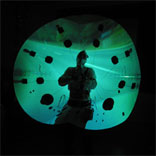 |
VIDEO PEACOCKBenoit Maubrey (USA/F) In the more recent AUDIO PEACOCKS project wearable electronic instruments are constructed from polycarbonat plexiglass material shaped into a peacock's fan-like plumage. The plexiglass surface is equipped with 16 loudspeakers (150 watts power), amplifiers, and rechargeable 12 volt batteries. The "audio-plumage" is highly directional and functions like an electroacoustic radar dish. An Audio Peacock can use its own site-specific electronic instruments (see Ballerinas) or amplify and alter its voice using a built-in microphone, sampler, and digital filter mechanisms. The Peacock can also receive sounds from outside sources via transmitter/receiver and disseminate them in a space by orienting its high-tech "plumage". VIDEO PEACOCK is the most recent performance project from Benoit Maubrey. An Audio Peacock costume made from white plexiglass is used as a mobile projection screen. In this audio-visual performance the electro-acoustic quality of a Peacock is visually enhanced via a video projector. Video-taped images are projected simultaneously to the sounds on the costume. In a more spectacular sense the Peacock's own real-time image can be projected live onto its costume as a form of "video-feedback". Additionally its own voice and sounds can be used to manipulate the projected images: in effect the Peacock "wears" its own sound. |
|
 |
IMPROVeRichard Widerberg & Zeenath Hasan (FIN) This mobile music work is an aural architecture for socio-cultural exchange. Sonic realities of the everyday are improvised live in a non-linear mode. Local and remote audiences contribute and access open content. IMPROVe explores the role of the mobile phone user as a creator of her/ his own content. It attempts to define the mobile device as a tool for environment awareness by making the user conscious of their immediate sonic surrounding. By exploring the role of the mobile phone as a medium of sonic content creation and exchange, we propose the understanding of the music making mobile device as a medium of empowerment. |
|
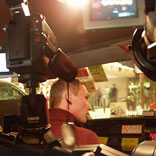 |
staTdT_kunst_ZURICHHannes Raffaseder & Kurt Hörbst (AUT) Zürich_14.07.06 is part of the ongoing project staTdT_kunst. The title has two different meanings: 'statt Kunst' (instead of art) deals with the role and significance of (contemporary) art in our society, while 'stadt kunst' (city art) uses field recordings of specific sounds and voices, photos and videos sourced in the city or documentary-style interviews with people passing by as basic material for an audiovisual live-performance. Filtered through the artists subjective point of view, this footage is deconstructed, categorised, transformed, and then re-assembled into a site specific mutlimedia live performance. The project 'staTdT_kunst' began with a performance in in Linz in March 2002 and has grown to include new cities and new results. A 'snapshot' of a specific day will be developed further for Zürch. On July the 14th audio and video materials will be collected during the course of a single day. These materials may included city sounds and voices, videos, photos and recordings of the workshops and lecture of the Digital Art Week that focus on the theme of the day, Malleable Scores, ReScoring and Live- Coding. These will then be transformed and remixed during their performance in real-time into the newest version of a staTdt_kunst project. For past projects, please visit: http://www.stadtkunst.com |
|
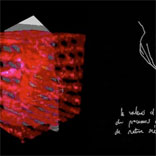 |
GRENZE: Lectures of the Capital by Karl MarxPatrick Fontana, Emeric Aelters and Pierre-Yves Fave (FR) You are invited to discover the video performance Grenze (2D and 3D computer animation) according to the Capital of Karl Marx. Our generation's experience : Capitalism won't die of natural death. We intend through these particulars lectures of Marx's Capital to open interrogations about social and economics context of today's Capital. In GRENZE, the principal question thus goes on the movement, the circulation of capital and its transformations. It places progressively series of metamorphic movements. It articulates with it. It gives it a visual translation. Our look, our waiting, time respond together to this construction of an infernal mecanism which holds everything. It opens a range of questions as how today's capital catches ours lives, our subjectivities there "Your capacity" to be put in images "words found a form and a space which enable him to appear in all its power. I imagine that a multitude of singular forms are possible starting from the elements thus assembled. I do not know if thus Eisenstein would have put out of film the Capital, but you undoubtedly found a manner strong and tempting to carry out its dream" Jacques Rancière, professor of philosophy. |
|
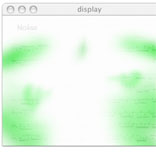 |
TUNINGSDavid Kim-Boyle (USA) Unlike many of my compositions which are concerned with the slow transformation of timbre, in tunings I was interested in discontinuity, fragmentation and an exploration of the space between the gestures. Of particular interest was a musical model based on the idea of a radio tuning into different stations, sometimes pausing, often moving on. During a performance, the cellist reads a score from a computer monitor - sometimes they are asked to perform from traditional notations and sometimes to interpret various graphical gestures. Unlike a traditional score, this 'score' dynamically changes in real time ensuring a spontaneity from performance to performance. The sounds produced by the cellist are modified by a separate computer running Cycling '74's MaxMSP which is also used to generate sonic textures which complement the cellist and extend the tuning metaphor further. tunings was written for cellist Franklin Cox in the Spring of 2006. Many thanks to Frank for sharing his enthusiasm and passion for all things unorthodox in the world of the cello. |
|
 |
STRANGERSmith/Wymore Disappearing Acts (USA) Stranger is a dance theater multimedia work for three dancers, three suitcases, laptop and a video camera. The work explores identity in this time of information saturation via hundreds of images from Google image searches, random text generators, audience questionnaires and manipulated live feed video. The work asks us to consider what is happening to our sense of ourselves as we dive deeper into the electronic sea. What is our identity in this non-corporeal, unpredictable, unsecured and insecure, massively tethered yet infinitely diverse and pan cultural environment? Smith/Wymore Disappearing Acts is a Berkeley, California based dance-theater company founded and directed by Sheldon B. Smith and Lisa Wymore. Their performance works create abstract narratives built on a foundation of physical experimentation, improvisation, text, song and digital image. The result is a new aesthetic that is at once oddly familiar, and beautifully odd. www.smithwymore.org |
|
 |
FOUR WHEEL DRIFT [REMIX]Julie Andreyev & Jordan Benwick (CAN) Four Wheel Drift [remix] is site-specific in that it relies on the unique urban qualities of the host city. Influenced by the artist group Situationists International (1957 - 1972), the project employs the tactic of the 'derive' (translates as 'drift') to cruise the city seeking out unexpected urban performance. In preparation for the FWD [remix] performance, cameras and microphones provide video imagery and sound of the car's environment that is manipulated by the interaction of the car and driver to provide an audio/visual storytelling of the city's street culture. These records become the playlist used by software and the DJ and VJ (visual jockey) to generate live video panoramas and soundscape during the [remix] performance. Each time it is performed, Four Wheel Drift [remix] involves collaborative processes that provide audio and video data unique to the host performance city. Originally produced in 2004 by Julie Andreyev in technical collaboration with Jordan Benwick, the project involves additional modes of collaboration, such as those between the car and driver, between the production team and a local participant, and between the [remix] performers. Creation takes place 'on-the-fly' in a public setting rather than in the isolation of the studio. |
|
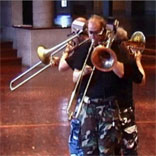 |
HUDDLE [GoingPublik]Art Clay (USA/CH) & Erratum Ensemble* (INT) GoingPublik is a sound art work for distributive of trombones ensemble and wearable computers. The core idea behind the work is a strategy of mobility by employing the wearable computer system to run a software based electronic score, allowing for what might be termed 'composed improvisation'. This lets improvisational elements mix within a compositional structured music. By electronically monitoring the performer's physical position in and movement space during performance using universal inputs such as geographical positions obtained via satellites and sensors using the earth's magnetic field, the score program can make suggestions and demands on the performer to various degrees and at various times. The contents of the score thereby linked directly to the movements of the performer and thus creating a unique choreographic metaphor of sound dispersing in space. *The players of the ensemble are Roland Dahinden (CHE), Günter Heinz (DEU) & Thierry Madiot (FRA) and have performed the work at various festivals and events since 2000. |
|
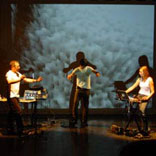 |
S.S.S TRIOAtau Tanaka, Cecile Babiole & Laurent Dailleau (FRA) This trio with artists Cecile Babiole, Laurent Dailleau, and Atau Tanaka create together a dynamic sound and image environment. S.S.S is a trio performing visual music with sensors and gestures. They create a work of sound and sight, a laptop performance that goes beyond with the intensity of bodies in movement. Going beyond media: music that is more than a soundtrack, images going further than video wallpaper. A three-way conversation modulating sonic and luminous pulse and flow. Sensors capture gesture and corporeal movement, translating them into digital data: Ultrasound sensors measure the distance between the performer's hands and her machine, allowing her to articulate 3D imagery, navigating in color, scale, texture? The Theremin, historical electronic instrument invented in 1919, an oscillator responds to perturbations of electrostatic fields based on the distance of the hands and body to the instrument? The BioMuse places gel electrodes on the performer's forearms, analyzing EMG biosignals. Muscle tension through concentrated movement allows the musician to sculpt sound synthesis. S.S.S's singular approach brings them to present their work in a wide range of contexts in music and the digital arts. They are equally at home performing in galleries or underground spaces, in arts centers or research laboratories. |
|
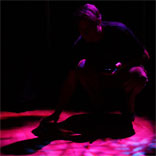 |
VIRTUAL DJSteve Gibson (CAN) This work uses the tracking capabilities of the Gesture and Media System to allow one or more users to use space as an audio remix or performance tool. Users literally wave their arms, and as if by magic new audio loops are accessed, synthesizer filters are opened, samples are played, and drum loops are started. Simultaneously robot lights follow the users, dynamically changing in relation to their position and the audio. Virtual DJ is part of a larger research project entitled Moveable Feast, which was sponsored by CANARIE, Canada's high-speed research network agency. The primary intent of this research project was to create innovative and meaningful projects for presenting content over high-speed networks. The secondary intent was to explore the use of the Gesture and Media System (formerly the Martin Lighting Director) as an expressive tool for performance and audience interaction with lights, sound and images. The Gesture and Media System allows artists to 'map' an interactive space with sound, light and images, and to have user-movement dynamically control these elements via a small 3D tracker. |
|
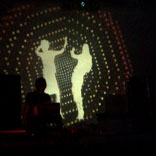 |
JUMP'N'RUNLive Visuals by Corebounce (CH) Sounds and Bits by Steve Gibson (CAN), Randy Adams (CAN) and Leonard J. Paul (CAN) The closing performance of DAW06 will let you immerse into a space of pixels and samples and... |